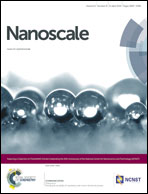Urchin-like polypyrrole nanoparticles for highly sensitive and selective chemiresistive sensor application†
Abstract
Urchin-like polypyrrole (U_PPy) nanoparticles with various diameters were fabricated using a dual-nozzle electrospray and vapor deposition polymerization (VDP). Metal oxide nanoneedle-decorated PPy (FePPy) particles were fabricated as starting materials for deposition of a PPy layer on the metal oxide surface. The FePPy particles were prepared by heating and stirring an aqueous solution of the metal precursor and electrosprayed PPy (E_PPy) particles with nucleated sites on the surface. U_PPys with a maximized surface area were then formed by soaking in an initiator solution followed by VPD. The U_PPy particles were evaluated in various hazardous chemical gas sensors at room temperature. Because of their larger surface area, U_PPy based chemiresistive sensors exhibited greater sensitivity and ca. 10–100 times higher minimum detectable levels (MDLs) of common analytes than pristine PPy particle-based sensors. For example, the MDL of NH3 was approximately 0.01 ppm, which is better than that observed for other conducting polymer nanostructures. Our new fabrication methodology promises to be an effective approach for fabrication of hybrid nanostructures for future sensing technologies.


 Please wait while we load your content...
Please wait while we load your content...